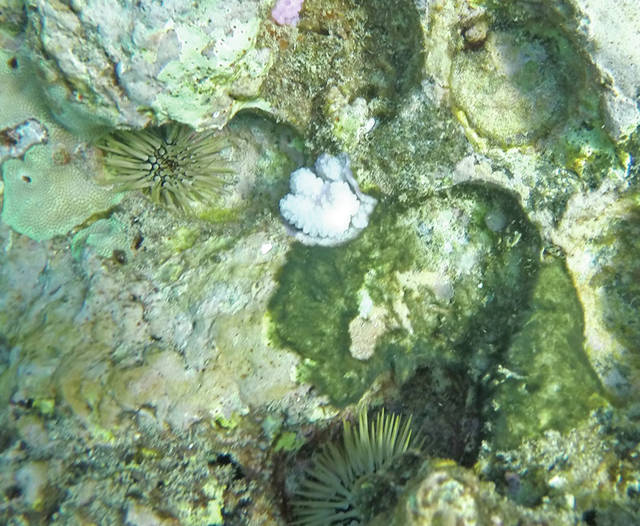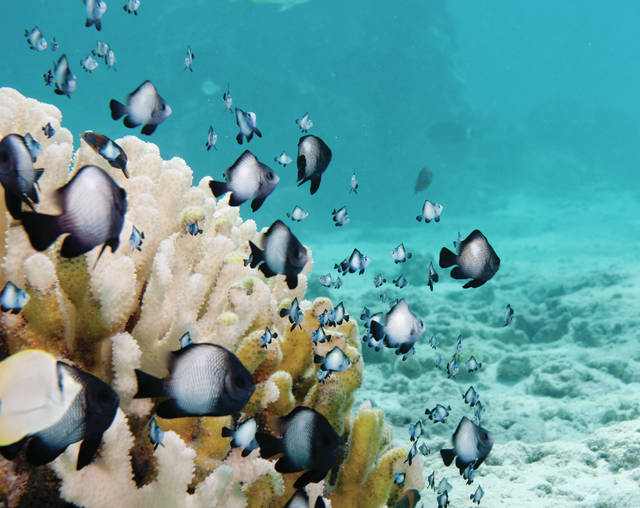KOHALA COAST — For the past three years or so, ideal snorkeling spots such as Kauna’oa Bay have appeared nearly dormant. Where vibrant yellow, green and blue corals were once plentiful, mostly dead, grey-colored ones remained.
Until recently.
“Some areas were hit harder than others by the coral bleaching event, and there were a few areas where more corals survived,” Lindsey Kramer said, who has studied the effects of warmer ocean temperatures in West Hawaii since 2015 as Habitat &Fish Monitoring Island coordinator for the State’s Department of Land and Natural Resources’ Division of Aquatic Resources (DAR).
Kramer is also the Hawaii Island coordinator for Eyes of the Reef Network (EOR), a volunteer member-based organization created to increase public awareness and engage monitoring and reporting of coral bleaching and disease, among other sea-related topics.
“Cauliflower coral was extremely susceptible to bleaching in 2015 and more than 99 percent was bleached in West Hawaii,” she said. “In December 2015 we started to see mortality and it continued into the spring of 2016.”
The peak event that caused dramatic loss in coral cover on the island’s west side was predominantly a thermal stress event that began in August 2015 and continued through November that year.
“Ocean temperatures reached 86 degrees. Increasing levels of carbon dioxide emissions to our atmosphere act like a greenhouse and trap heat,” Kramer said. “The very warm ocean temperatures we experienced here in 2015 were a clear warning that the climate is changing.”
At the same time, there were other effects beyond stressed corals.
“We saw an increase in dead cliff oysters just after the coral bleaching in winter 2016. It’s possible that the rise in temperature affected other invertebrate species,” Kramer explained.
DAR began gathering data on coral health in 2003 and monitored reefs throughout the bleaching catastrophe.
Signs of new life
Recent DAR data for North Hawaii has shown an overall coral recovery of 1 to 2 percent over the last two years at the majority of their monitoring sites.
“Of the six sites in North Hawaii, Puako was the only one that continued to have coral decline between spring 2016 and spring 2017,” Kramer said.
Beginning in May of this year, new small, tan cauliflower coral were seen growing atop dead coral at Kauna’oa and among larger live corals that survived at Mauna Lani. Other sites, such as Lapakahi, also showed signs of coral on the rebound.
“The very small coral colonies you might see out there are likely new ones that settled on the reef as larvae, and the larger colonies are possible survivors of the bleaching event,” Kramer said. “One hypothesis is that those areas with more corals have cooler groundwater frequently influencing them, which could reduce susceptibility to bleaching.”
Corals can survive in the bleached state for several weeks, but the reasons some live while others die are related to species or individual traits.
“It’s important to consider watershed, water pollution and other local stressors, such as the chemicals in sunscreens,” Kramer said. “It’s safest to use sunscreens that are titanium oxide or zinc oxide based.”
Another key to the coral’s rebirth in North Hawaii has been a spawning observation program EOR hosted in spring 2016.
“As the coral spawns, an individual colony can produce both male and female gametes. They are released and fertilized in the water column,” Kramer said. “The cauliflower coral spawns based on cues related to the lunar cycle, about three days after the full moon in spring. Sometimes the larvae can travel in the plankton and resettle in other areas.”
DAR is continuing to look at collected data to find possible patterns.
“Eggs were viable this year and lab-rearing of larvae and tank settlement experiments were successful so there’s future restoration potential. The work was done by group of DAR and collaborating scientists and volunteers at six locations,” Kramer said.
EOR’s community reporting network, comprised solely of volunteers, provides free training for residents to learn more about coral bleaching and what happened in 2015. Roy Allen, a Waikoloa Village resident who snorkels regularly, volunteered for EOR several years ago.
“The training they offer is fantastic. It really helps us to understand what’s happening with the ocean, particularly now with the dramatic changes. It gives everyone a chance to help,” he said.
Earlier this year, a volunteer team at Mahukona reported light coral spawning May 1 and more active spawning May 2. On June 1, Kramer was out at Mauna Lani to observe the spawning event.
“We asked EOR volunteers to help us observe the spawning and its timing,” Kramer said. “At Mauna Lani it was exciting to see a successful spawning event after two years of low reported activity.”
She continued, “The EOR program also offers information on how to identify coral disease, marine invasive species and invertebrate disease. When people are out snorkeling or diving and notice something unusual, they can report to us on our website. It’s a grassroots effort that partners with State of Hawaii coral reef resource managers. They review and verify the reports and respond if needed.”
Much of what DAR does is based on a Coral Bleaching Recovery Plan created by University of Hawaii Social Science Research Institute in winter 2015 and released in 2016.
“It is a planning document describing the best possible management strategies to help the coral to recover in West Hawaii,” Kramer said. “It includes key strategies such as watershed improvements, protection of reef grazers and coral restoration.”
It also describes coral restoration strategies to improve coral resilience to stress, to develop faster growth methods and scale-up efforts to a meaningful scope.
“The number one strategy is to create a network of protected areas to promote coral resilience,” Kramer said. “It’s quite a process to determine what areas would be candidates, and strong community support will be a critical factor.”
Protecting coral moving forward
In January, the Center for Biological Diversity filed a petition to list cauliflower coral in the U.S. as endangered or threatened under the Endangered Species Act, with less than 5 percent of its population remaining in West Hawaii as a driving concern.
“It’s still in its early stages and open for public comment,” Kramer remarked.
DAR continues to monitor coral closely in waters surrounding the Big Island.
“Currently, we’re under a bleaching watch in Kona. This week it was 81.8 degrees,” Kramer said last Monday. “The corals start to get stressed leading up to 82 degrees and the effects worsen as temperatures remain warm.”
For the remainder of 2018 and the next several years, DAR will continue their coral monitoring efforts. Free public trainings on coral bleaching and health are offered throughout the year by the Eyes of the Reef Network.
Info: Email EOR.Hawaii.island@gmail.com





